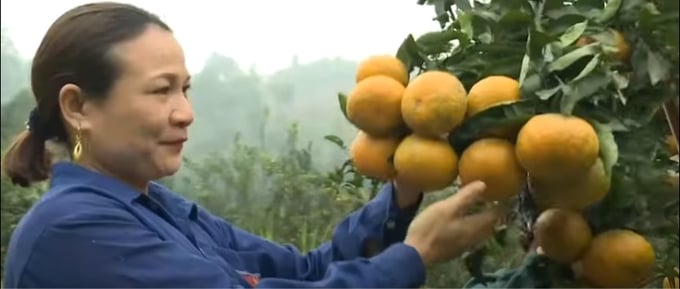November 25, 2025 | 06:37 GMT +7
November 25, 2025 | 06:37 GMT +7
Hotline: 0913.378.918
November 25, 2025 | 06:37 GMT +7
Hotline: 0913.378.918
In recent times, the crop production industry has generally made significant contributions and has an important position in the entire agriculture sector.
Specifically, the crop production industry accounts for 63% of the total value of the agriculture sector. Exports account for over 50% of the agriculture sector, reaching USD 27 billion last year. 80% of farmer households nationwide are involved in the crop production industry.

Hoa Binh province has many crop products participating in national product chains in restructuring the crop production industry, such as rice, corn, citrus fruits, tea, etc. Photo: VAN.
Besides, Vietnam's crop production industry plays an important role in ensuring national food security, in which rice is determined by the State as the core of ensuring national food security.
Sharing about the Strategy for Crop Production Development until 2030, with a vision to 2050, with Vietnam Agriculture Newspapers, Dr. Bui Ba Bong, former Deputy Minister of Agriculture and Rural Development and Chairman of the Vietnam Rice Sector Association, said that the strategy approved by the Prime Minister this time is a good opportunity for the crop production industry to consolidate and promote the industry's strengths to a higher level than the foundations already achieved in the coming time.
Hoa Binh is a mountainous province with many specific climatic conditions and sub-regions that have created the value of ecological diversity and diversity in crop products.
According to Mr. Vuong Dac Hung, Deputy Director of the Hoa Binh Department of Agriculture and Rural Development, the value of crop production accounts for a very large proportion (about over 60%) in the agriculture, forestry, and fisheries sectors of Hoa Binh province. In livestock and crop production, crop production accounts for about 70%.
Hoa Binh has many key products with advantages and growing brands in the market and many products in the field of crop production that have participated in national product chains in restructuring the crop production industry, such as rice, corn, citrus fruits, tea, and other products. Hoa Binh province has also added two provincial products to join the key product chain, which are medicinal herbs and fresh sugarcane.
"The national crop production strategy is a good opportunity to develop Hoa Binh province's crop products, thereby creating the diversity and brand for the province, bringing income to farmers, increasing economic value, and contributing to the province's socio-economic development," said Deputy Director Vuong Dac Hung.

According to Dr. Nguyen Nhu Cuong, Director of the Department of Crop Production, the Prime Minister's promulgation of the crop production strategy is considered a vision and an orientation for the crop production industry to develop in the current context. Photo: VAN.
Dr. Nguyen Nhu Cuong, Director of the Department of Crop Production, Ministry of Agriculture and Rural Development, said that if the crop production industry is developed in the traditional way as before, many things in the industry have reached their limit. For example, the development of rice, coffee, and pepper has basically reached its limit in terms of productivity and output.
"If we do not change our thinking, vision, and orientation, our crop production industry will stop or even go down. Thus, the Prime Minister's promulgation of the crop production strategy is considered a vision and an orientation for the crop production industry to develop in the current context," said Dr. Nguyen Nhu Cuong.
The Director of the Department of Crop Production added that in the current world context, as well as the country facing issues of food security, climate change, environmental responsibility, and green production, the Prime Minister's decision to promulgate a crop production strategy creates a breakthrough, shaping to "hit the ceiling" for the development of the crop production industry according to new trends.
It means that the crop production industry develops in the direction of exploiting multiple values, following the market's needs and orientation, and ensuring issues of environmental responsibility and emission reduction.
Explaining more about the breakthrough in the strategy approved by the Prime Minister this time, Dr. Nguyen Nhu Cuong said that the strategy's development goal here is not as defined in terms of the amount of planting area, yield, or selling value as before. Instead of rigid orientations as previously, the strategy provides a general framework and orientation for each type of product, each crop type, and each region based on advantages and inclusive changes, from simple production based on output and productivity to economic production based on the market.
The perspective of the Strategy for Crop Production Industry Development until 2030, with a vision to 2050, is that production aims to develop multi-values and bring the highest efficiency to farmers, not development to bring the highest productivity or output on a particular product.
Translated by Thu Huyen

(VAN) Viet Nam is entering the pivotal period of 2025-2030, moving toward the formulation of the Remote Sensing Law, which will establish a legal foundation for the development of national digital data.

(VAN) The agricultural sector is finalizing the strategic framework for emission reduction, setting the goal of sharply cutting methane and 403.7 million tons of CO2 equivalent and moving toward Net Zero by 2050.
/2025/11/22/2236-1-153832_483.jpg)
(VAN) The National Marine Spatial Planning is opening up opportunities for sustainable blue sea development across 21 coastal localities.

(VAN) Viet Nam’s forestry sector is undergoing a comprehensive transformation, strengthening management, protection, and development efforts to maintain ecological security and drive green, sustainable growth.

(VAN) Viet Nam is accelerating efforts to digitize reservoir operations, from real-time data to hydraulic modelling.
/2025/11/21/3348-2-102623_454.jpg)
(VAN) National Assembly delegate Nguyen Thi Lan has proposed adding special mechanisms to attract human resources to the agricultural, forestry, and fishery sectors, addressing the shortage of high-quality personnel.

(VAN) Over the past two decades, the unified legal framework for water resource management has been perfected, becoming a crucial foundation for ensuring national water security.